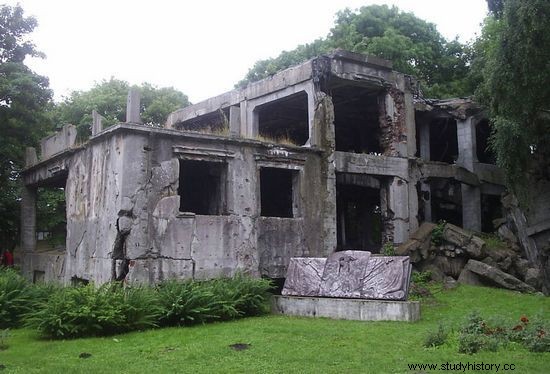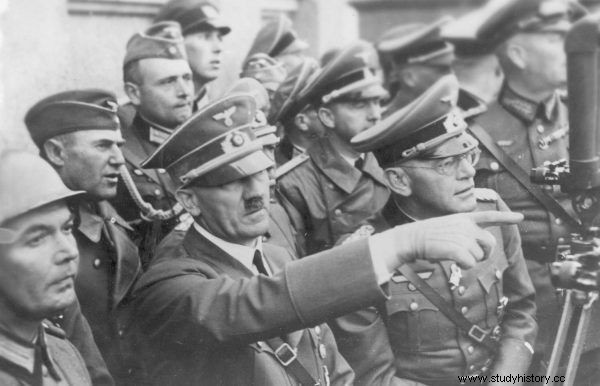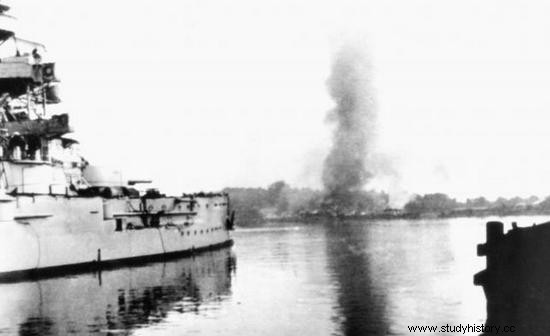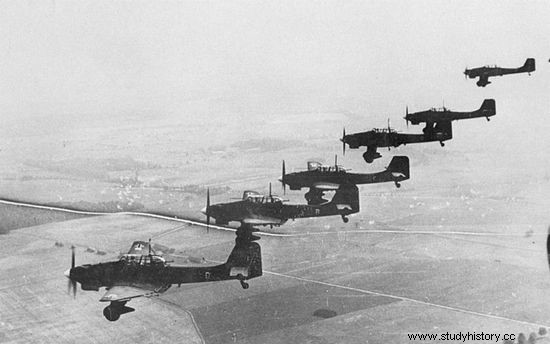It all started on September 1, 1939, at 4:45 am, when the battleship "Schleswig-Holstein" opened fire towards Westerplatte. Over the next seven days, the defenders repulsed thirteen strikes and more than a dozen forays, killing and injuring nearly 1,000 Germans. Eventually, however, they had to surrender. So much for the legend. What does the truth look like?
This is quite different from the myth of the siege of Westerplatte that has been instilled in us over the years. We should start with the fact that the very time of the beginning of the shelling of the Polish outpost by the old battleship is wrong.
Indeed, as planned, it was supposed to start at 4:45, but due to problems with the correct positioning of the ship, the first volleys were fired three minutes later. Therefore, the beginning of the fights must be set at 4:48 . Someone will probably say that this is a detail, and he will be right. So let's move on to what is really important.
They fought 3,000 Germans and repulsed 13 attacks
It is commonly believed that the German forces directly involved in the assaults were incomparably larger than the staff of the Military Transit Depot, which numbered just over 210 soldiers. Up to three thousand Germans are often spoken of. What was it really like?

So much today is left of the barracks where the crew of the Military Transit Depot lived (photo:Jan Jerszyński, license CC BY-SA 2.5).
Indeed, the attackers had an advantage, but not that overwhelming. According to what Jarosław Tuliszka writes in the book "Westerplatte 1926-1939", their number did not exceed 1000 (not counting of course the crew of the battleship).
Even more detailed data can be found in the work "Boje Polskie 1939-1945. Encyclopedic Guide ". The author of the slogan devoted to the battle of interest to us emphasizes that, according to the latest research , about 570 soldiers and policemen took part in the direct attacks on Westerplatte .
Since we already know what forces the defenders had to fight, now we should focus on another myth. Namely, the repeated information about thirteen strikes repelled. In fact, on the Internet you can even find texts about fourteen German storms and nineteen night forays! Of course, all this should be put into fairy tales.
In fact - as Jarosław Tuliszka emphasizes - the Germans carried out only two general assaults and one attack which was a deep reconnaissance combat. Both attacks took place on the first day of the struggle and - as we know perfectly well - were bloodily repulsed. The attackers lost nearly 40 dead and many wounded, several of whom later died in hospitals. This expensive lesson gave the German command food for thought.
The next general assault was postponed several times, focusing on other areas of activity. After all, Hitler himself allowed the assault to take place on September 8. The day before, however, it was decided to carry out the aforementioned attack, which is a deep combat reconnaissance.
Several Germans were injured during it, but no one was killed. Due to the capitulation of the defenders, there was never a third - this time well prepared - attack, which would probably end in a massacre of the Polish crew.

Permission to postpone the third general assault to September 8 was issued by Hitler himself.
They were continuously fired from land and sea and bombed from the air
Another myth is the information that Westerplatte was almost non-stop under heavy fire from land and sea throughout the entire siege, additionally supported by cyclical bombing raids. The analysis of German sources allowed Jarosław Tuliszka to accurately recreate the scale of the hostile pressure. It turns out that during the entire period of fighting "Schleswig-Holstein" only fired on the first and last day of fighting depots from their departments.
On September 1, there were three approaches, lasting respectively 7, 37 and 26 minutes. Six days later, the battleship also used its deck artillery three times, firing a total of nearly two hours. It should be emphasized here, however, that contrary to the recently promoted theories, the firing was quite effective - especially the one from September 7th.
The attacks from the sea also include - which was opened twice on September 4 - short-term fire from 105-mm guns of the old torpedo boat "T-196" and a five-minute fire from the minesweeper "Von der Groeben" that day. So much for the participation of the Krigsmarine.

"Schleswig-Holstein" shells Westerplatte. The on-board artillery of the old battleship twice (September 1 and 7) targeted the Military Transit Depot.
And what did the Luftwaffe attacks look like? Even more modest, but with better results. At the outset, it should be emphasized that the German air force carried out only one raid on Westerplatte! Initially, it was planned for September 1st. Finally - after postponing the attack time several times - only shortly after 6 p.m. the next day 58 Junkers Ju 87B Stuka dropped 26.5 tons of bombs on designated targets.
The raid was very effective and caused a lot of confusion in the ranks of the defenders. Additionally, one of the 500 kg bombs destroyed Guardhouse No. 5, killing seven Polish soldiers and injuring two more. This was the end of the Luftwaffe's participation in the fighting for Westerplatte.
As in the case of the navy and aviation, the land artillery also did not show excessive activity. In addition to the attackers using several anti-tank guns on the first day, it was not until September 5 that a 105mm howitzer battery was used, which fired 200 rounds.

On September 2, after 6 p.m. 58 Junkers Ju 87B Stuka dropped 26.5 tons of bombs on Westerplatte. It was the only attack by German planes on the Military Transit Depot.
The next day, the Germans fired a heavy mortar and artillery battery at Westerplatte. Also this time it did not cause the expected damages. Therefore, it can probably be concluded that another myth has fallen.
Has Sucharski broken down?
Another issue that raises considerable controversy is the issue of command of the defense after the aforementioned raid. As it was indisputably established, in the late afternoon of September 2, Major Henryk Sucharski decided to surrender and ordered a white flag to be raised. However, his deputy, captain Franciszek Dąbrowski, opposed this order and thanks to the support of most of his subordinates, the fight continued.
Was Sucharski's decision dictated by - as some would like - a nervous breakdown, or was it the result of sober judgment and knowledge that others did not have? To answer this question, go back to August 31, 1939
On that day, Lieutenant Colonel Wincenty Sobociński from the General Commissariat of the Republic of Poland in Gdańsk arrived at Westerplatte. He passed on some important information to Sucharski. Among other things, that according to the findings of the Polish intelligence, the Germans will attack in the next 24 hours and that the defenders cannot count on any outside help!

The truth about the horror of the German occupation in the book by Dariusz Kaliński entitled "Balance of harms" .
He also delivered the order to defend for 12 hours - previous orders had said six hours - which was to be a manifestation of the Polish will to fight. So, as we can see, major Sucharski's decision to surrender was not dictated by a nervous breakdown, but rather by a sober assessment of the reality.
The defense lasted more than three times longer than planned, and there was no chance of recovery. In turn, Captain Dąbrowski, not knowing the whole truth, simply committed open and unjustified insubordination. Although it should be emphasized that he acted in good faith.
How long was the defense and what losses did both sides suffer?
Moving slowly towards the end, two more questions remain to be answered. The first is how long the defense actually lasted? For decades it was considered seven days. Again, there is a misinterpretation of the facts. The fighting started on September 1 at 4:48 am and ended - the Germans spotted the white flag - on September 7 at 9:30 am. So it was 6 days 4 hours 42 minutes.
The second issue revolves around the number of casualties on both sides. Some say the Germans lost up to 1,000 killed and wounded. A more conservative estimate was that there were 300-450 killed and wounded. The latest findings, however, strongly verified these hypotheses.

The Westerplatte crew stayed at the post for over six days. The photo shows Polish soldiers going into German captivity.
According to them, direct German losses amounted to about 50 killed and 150 wounded. As for the Polish victims, it can be assumed that there were at least 15 killed and about 40 wounded and injured.
These are just some of the myths of Westerplatte. Soon a controversial film about the defense of the Military Transit Depot will be released in theaters, so it's time to recall what it really was like. Even if the version preserved by propaganda for decades seems more interesting to some.
Check where to buy the "Balance of harm. What did the German occupation of Poland really look like ":
